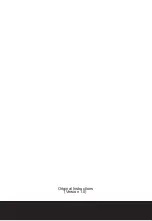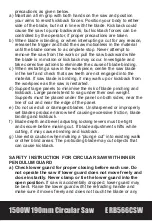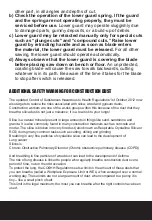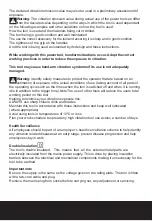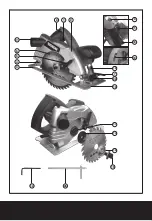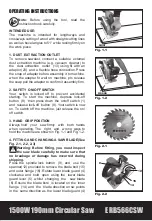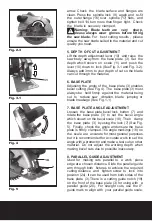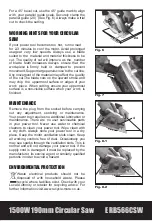
Less than a full tooth of the blade teeth should be visible below
the workpiece.
d) Never hold piece being cut in your hands or across your
leg.
Secure the workpiece to a stable platform. It is important
to support the work properly to minimise body exposure, blade
binding, or loss of control.
e) Hold power tool by insulated gripping surfaces when
performing an operation where the cutting tool may contact
hidden wiring or its own cord.
Contact with a “live” wire will
also make exposed metal parts of the power tool “live” and shock
the operator.
f) When ripping always use a rip fence or straight edge guide.
This improves the accuracy of cut and reduces the chance of
blade binding.
g) Always use blades with correct size and shape (diamond
versus round) of arbour holes.
Blades that do not match the
mounting hardware of the saw will run eccentrically, causing loss
of control.
h) Never use damaged or incorrect blade washers or bolt.
The blade Warning of explosive to dust washers and bolt were
specially designed for your saw, for optimum performance and
safety of operation.
FURTHER SAFETY INSTRUCTIONS FOR ALL SAWS
KICKBACK CAUSES AND RELATED WARNINGS
- Kickback is a sudden reaction to a pinched, bound or misaligned
saw blade, causing an uncontrolled saw to lift up and out of the
workpiece toward the operator;
- When the blade is pinched or bound tightly by the kerf closing
down, the blade stalls and the motor reaction drives the unit
rapidly back toward the operator;
- If the blade becomes twisted or misaligned in the cut, the teeth
at the back edge of the blade can dig into the top surface of the
wood causing the blade to climb out of the kerf and jump back
toward the operator.
Kickback is the result of saw misuse and/or incorrect operating
procedures or conditions and can be avoided by taking proper


